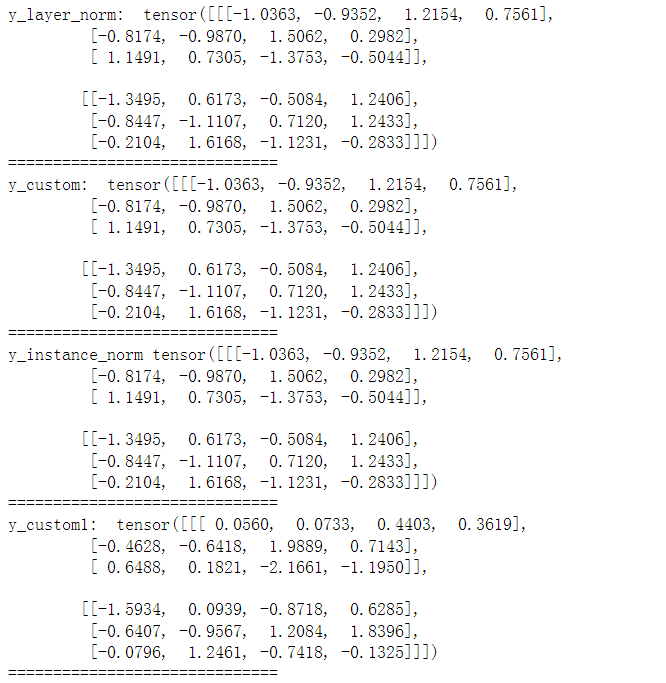zyh3826
September 20, 2022, 6:55am
1
I found the result of torch.nn.LayerNorm equals torch.nn.InstanceNorm1d, why?
batch_size, seq_size, dim = 2, 3, 4
x = torch.randn(batch_size, seq_size, dim)
#layer norm
layer_norm = torch.nn.LayerNorm(dim, elementwise_affine=False)
print('y_layer_norm: ', layer_norm(x))
print('=' * 30)
# custom instance norm
eps: float = 0.00001
mean = torch.mean(x, dim=-1, keepdim=True)
var = var = torch.var(x, dim=-1, keepdim=True, unbiased=False)
print('y_custom: ', (x - mean) / torch.sqrt(var + eps))
print('=' * 30)
# instance norm
instance_norm = torch.nn.InstanceNorm1d(dim, affine=False)
print('y_instance_norm', instance_norm(x))
print('=' * 30)
# follow the description in https://pytorch.org/docs/stable/generated/torch.nn.LayerNorm.html
# For example, if normalized_shape is (3, 5) (a 2-dimensional shape),
# the mean and standard-deviation are computed over the last 2 dimensions of the input (i.e. input.mean((-2, -1)))
mean = torch.mean(x, dim=(-2, -1), keepdim=True)
var = torch.var(x, dim=(-2, -1), keepdim=True, unbiased=False)
print('y_custom1: ', (x - mean) / torch.sqrt(var + esp))
print('=' * 30)
results:
In the results, I found LayerNorm equals InstanceNorm1d, and I custom the compute progress also found that the description in
LayerNorm doc maybe not correct? Do I miss something or LayerNorm and InstanceNorm1d in pytorch are absolutely equal?
Hope someone can answer this question, thanks!
snio89
November 2, 2022, 8:48am
2
This seems like a bug of nn.InstanceNorm1d when affine=False.
opened 09:02AM - 06 Jan 21 UTC
module: nn
triaged
needs design
module: norms and normalization
## 🐛 Bug
When `nn.InstanceNorm1d` is used without affine transformation, it d… oes not warn the user even if the channel size of input is inconsistent with `num_features` parameter. Though the `num_features` won't matter on computing `InstanceNorm(num_features, affine=False)`, I think it should warn the user if the wrong argument/input is being given.
## To Reproduce & Expected behavior
```python
import torch
import torch.nn as nn
# we define an InstanceNorm1d layer without affine transformation, where num_features=7
# note that affine is set False by default
m = nn.InstanceNorm1d(7)
# here, the input with the wrong channel size (3) is given.
input = torch.randn(2, 3, 5)
# the following operation should warn the user, although there's no problem with performing the computation.
output = m(input)
```
I'm not sure whether this is intended behavior or not.
## Environment
PyTorch version: 1.7.0+cu110
Is debug build: True
CUDA used to build PyTorch: 11.0
ROCM used to build PyTorch: N/A
OS: Microsoft Windows 10 Pro
GCC version: (MinGW.org GCC-8.2.0-3) 8.2.0
Clang version: Could not collect
CMake version: version 3.14.3
Python version: 3.6 (64-bit runtime)
Is CUDA available: True
CUDA runtime version: Could not collect
GPU models and configuration: GPU 0: GeForce RTX 2060
Nvidia driver version: 460.89
cuDNN version: Could not collect
HIP runtime version: N/A
MIOpen runtime version: N/A
Versions of relevant libraries:
[pip3] numpy==1.19.3
[pip3] pytorch-lightning==1.0.3
[pip3] pytorch-ranger==0.1.1
[pip3] torch==1.7.0+cu110
[pip3] torch-optimizer==0.0.1a15
[pip3] torchvision==0.8.1+cu110
[conda] Could not collect
cc @albanD @mruberry @jbschlosser
nn.InstanceNorm1d should take an input of the shape (batch_size, dim, seq_size).affine=False, nn.InstanceNorm1d can take an input of the wrong shape (batch_size, seq_size, dim) and provides a LayerNorm-like result.
1 Like
